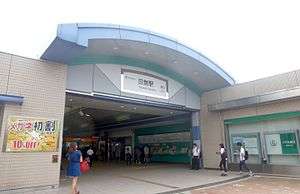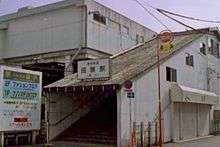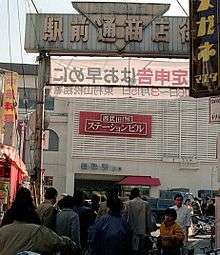Tanashi Station
Tanashi Station (田無駅, Tanashi-eki) is a railway station in Nishitōkyō, Tokyo, Japan, operated by the private railway operator Seibu Railway.
SS17 Tanashi Station 田無駅 | |
|---|---|
 Tanashi Station North Entrance, August 2015 | |
| Location | 4-1-1 Tanashi-chō, Nishitōkyō-shi, Tokyo (東京都西東京市田無町4-1-1) Japan |
| Operated by | |
| Line(s) | |
| Platforms | 2 island platforms |
| Connections |
|
| Other information | |
| Station code | SS17 |
| History | |
| Opened | 1927 |
| Traffic | |
| Passengers (FY2015) | 74,808 daily |
| Location | |
 SS17 Tanashi Station Location within Japan | |
Lines
Tanashi Station is served by the 47.5 km Seibu Shinjuku Line from Seibu-Shinjuku in Tokyo to Hon-Kawagoe in Saitama Prefecture. Located between Seibu-Yagisawa and Hana-Koganei, it lies 17.6 km from the Seibu Shinjuku terminus.[1] All trains except Limited express Koedo services and the Haijima Liner stop at Tanashi Station.
Station layout
The station has two elevated island platforms serving three tracks. Platform 2 and 3 share the same track.
Platforms
| 1 | ■ Seibu Shinjuku Line | for Tokorozawa, Haijima, and Hon-Kawagoe |
| 2 | ■ Seibu Shinjuku Line | for Tokorozawa, Haijima, and Hon-Kawagoe |
| 3 | ■ Seibu Shinjuku Line | for Takadanobaba and Seibu-Shinjuku |
| 4 | ■ Seibu Shinjuku Line | for Takadanobaba and Seibu-Shinjuku |
- The south entrance, March 2012
 The station platforms viewed from the east, August 2015
The station platforms viewed from the east, August 2015 The ticket barriers, August 2015
The ticket barriers, August 2015 Platform 3 and 4, August 2015
Platform 3 and 4, August 2015
Adjacent stations
| « | Service | » | ||
|---|---|---|---|---|
| Seibu Shinjuku Line | ||||
| Limited Express: Does not stop at this station | ||||
| Kami-Shakujii | Commuter Express | Higashi-Murayama | ||
| Kami-Shakujii | Express | Hana-Koganei | ||
| Seibu-Yagisawa | Semi Express | Hana-Koganei | ||
| Seibu-Yagisawa | Local | Hana-Koganei | ||
History


Tanashi Station opened on 16 April 1927.[1]
Station numbering was introduced on all Seibu Railway lines during fiscal 2012, with Tanashi Station becoming "SS17".[2]
Passenger statistics
In fiscal 2015, the station was the tenth busiest on the Seibu network with an average of 74,808 passengers daily[3]
The passenger figures for previous years are as shown below.
| Fiscal year | Daily average |
|---|---|
| 2000 | 69,945[1] |
| 2009 | 76,188[4] |
| 2010 | 75,106[4] |
| 2011 | 73,739[5] |
| 2012 | 74,148[6] |
| 2013 | 74,315[6] |
References
- Terada, Hirokazu (July 2002). データブック日本の私鉄 [Databook: Japan's Private Railways]. Japan: Neko Publishing. p. 202. ISBN 4-87366-874-3.
- 西武線全駅で駅ナンバリングを導入します [Station numbering to be introduced at all Seibu stations] (PDF). News Release (in Japanese). Japan: Seibu Railway. 23 February 2012. Archived from the original (PDF) on 2015-09-24. Retrieved 8 March 2013.
- 駅別乗降人員 2015(平成27)年度 1日平均 [Average daily station usage figures (fiscal 2015)] (PDF) (in Japanese). Japan: Seibu Railway. Archived from the original (PDF) on 3 August 2016. Retrieved 7 June 2015.
- 駅別乗降人員 2010(平成22)年度 1日平均 [Average daily station usage figures (fiscal 2010)] (PDF) (in Japanese). Japan: Seibu Railway. Archived from the original (PDF) on 26 June 2011. Retrieved 8 March 2013.
- 駅別乗降人員 2011(平成23)年度 1日平均 [Average daily station usage figures (fiscal 2011)] (PDF) (in Japanese). Japan: Seibu Railway. Archived from the original (PDF) on 1 November 2012. Retrieved 8 March 2013.
- 駅別乗降人員 2013(平成25)年度 1日平均 [Average daily station usage figures (fiscal 2013)] (PDF) (in Japanese). Japan: Seibu Railway. Archived from the original (PDF) on 14 July 2014. Retrieved 17 July 2014.
External links
| Wikimedia Commons has media related to Tanashi Station. |
- Tanashi Station information (Seibu Railway) (in Japanese)